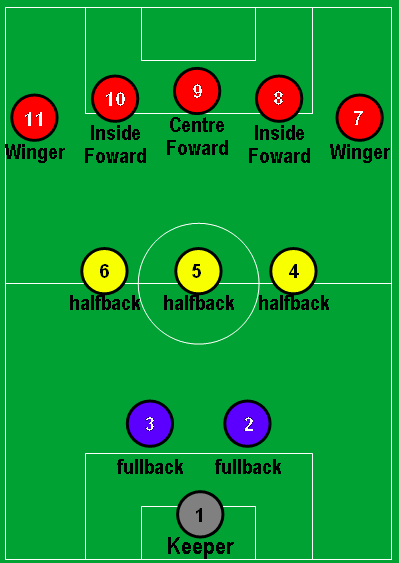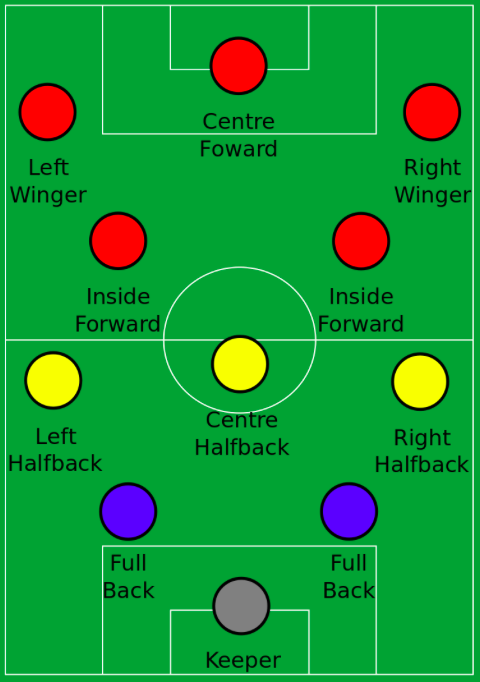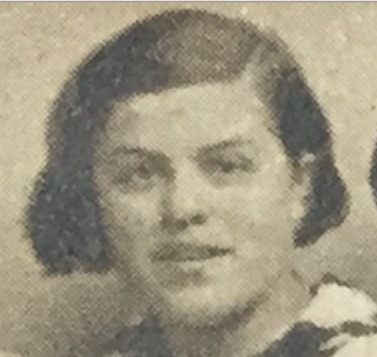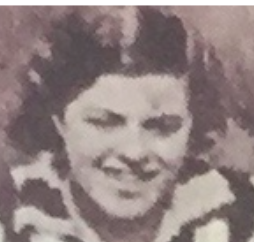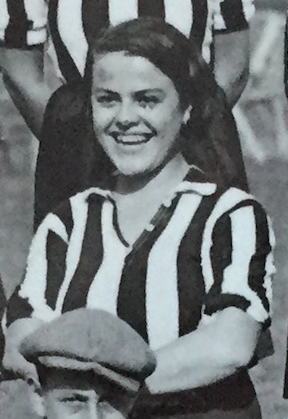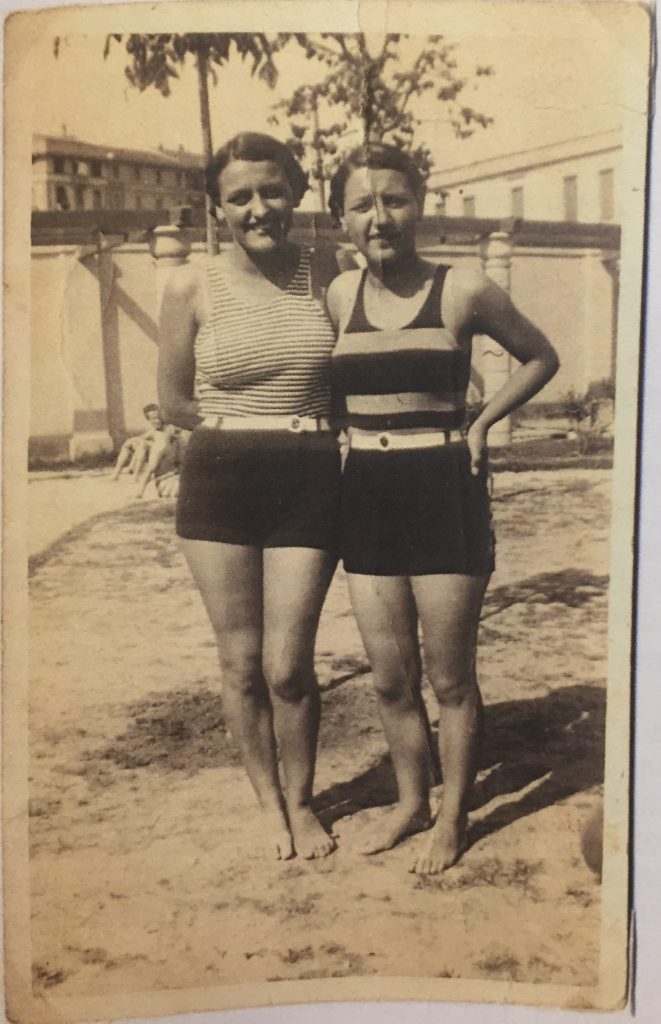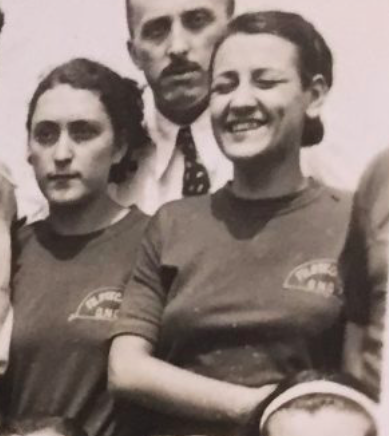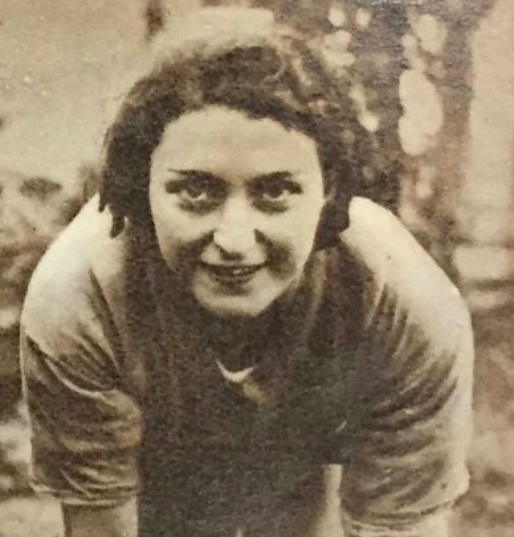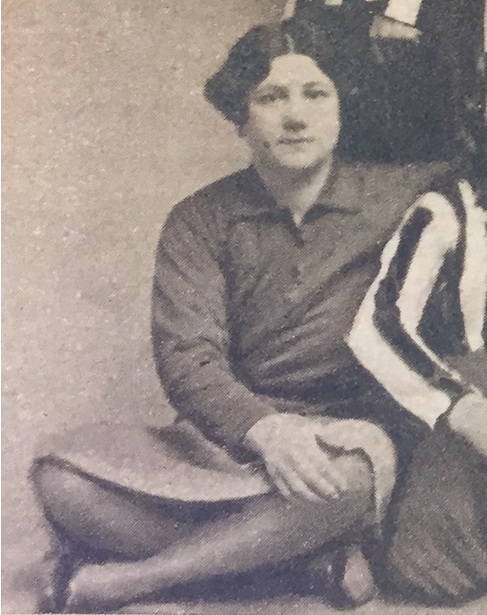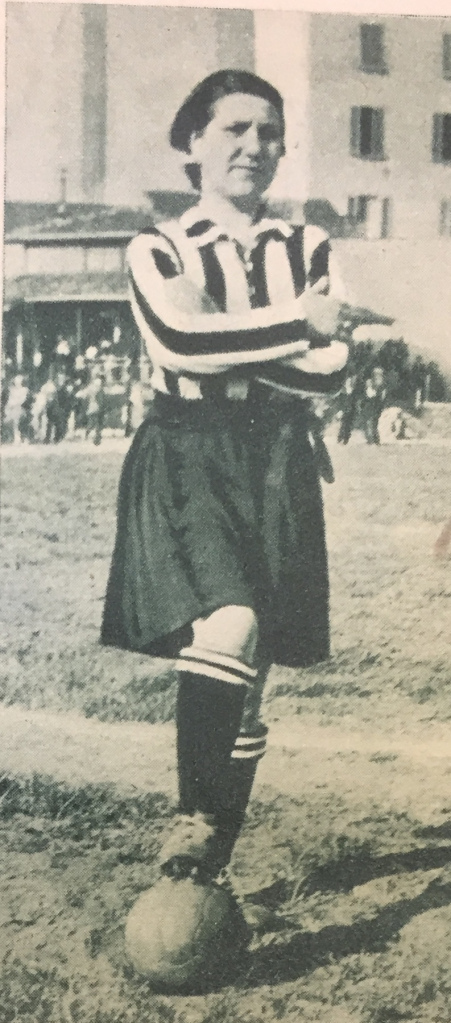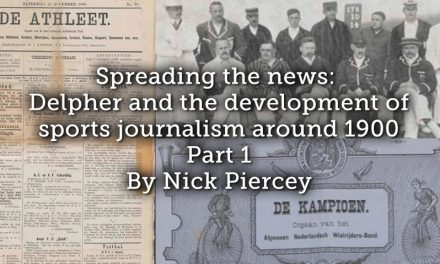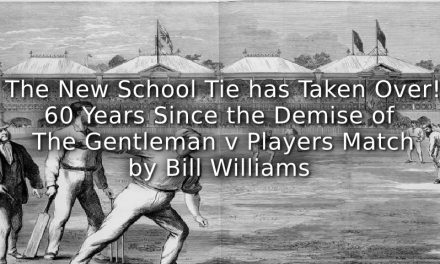The author would like to express thanks to: Luigi and Francesco Ferrari, Rosa Mottino, Francesco Bacigalupo, Paolo Gilardi for the photographs coming from the personal archives of their ancestors and to Alice Vergnaghi for the help in the analysis of such photographs.
PLEASE NOTE – Express permission is required to reproduce ANY of the images taken from these personal archives – please contact Playing Pasts or the author for more details.
To read the previous articles in this series please see the links below –
Part 1: Part 2: Part 3: Part 4: Part 5: Part 6: Part 7: Part 8: Part 9:
This last year turned out to be extremely useful for the reconstruction of the biographies of the Boccalini’s sister and heirs. The discovery of two new wonderful team pictures of GFC players in Giovanna Boccalini Barcellona’s archive shed a light onto three players about whose football activity no journalistic source had previously talked about.
Before coming onto these women, we need to say something about how male football team players were portrayed. Nowadays we are all accustomed to seeing the 11 (male or female) players standing in one row, or split into 2 casual rows, however, at that time players used to split into 3 specific groups, related to their playing position on the pitch. Let’s look to a 1933 Ambrosiana-Inter picture:
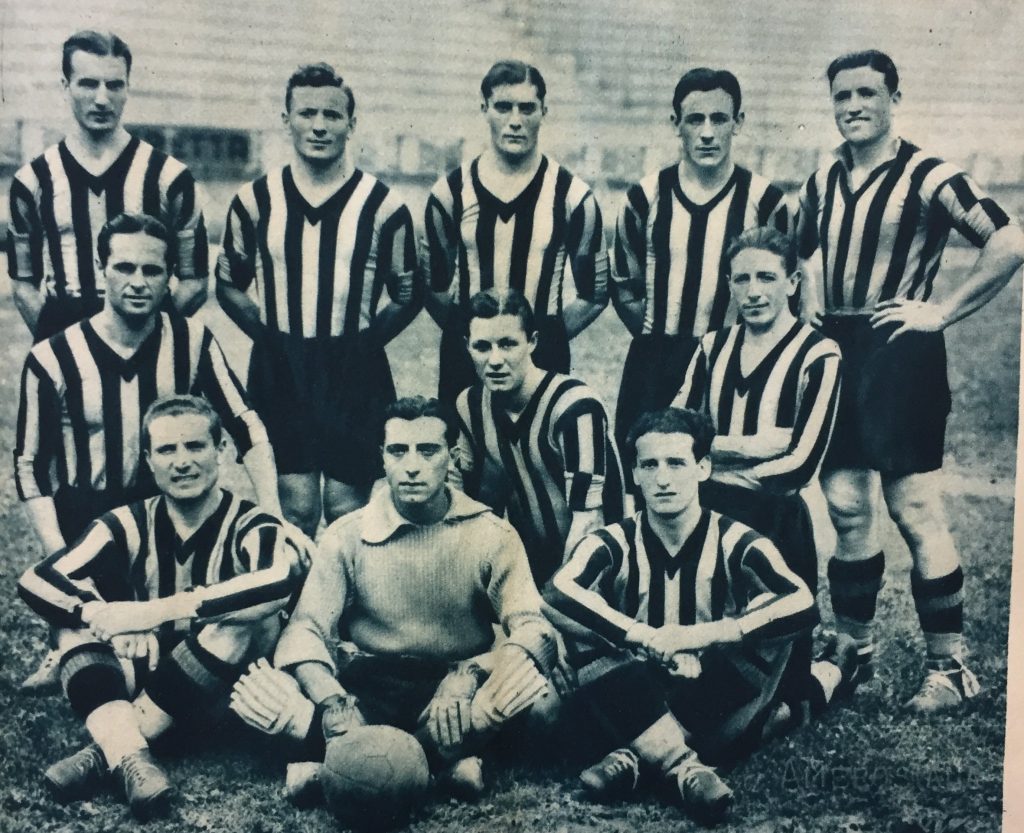
The Ambrosiana-Inter team at the beginning of 1933/1934 season:
Centre-forward Giuseppe Meazza is in the middle of the back row of standing players
Source: Cosmos, September 1933, p. 5.
This photographic structure was based upon the 2-3-5 formation (the Pyramid): the first or back row composed of the 5 forwards, who were always standing, the second or middle row by the 3 midfielders and finally the third or front row by the 2 fullbacks and the goalkeeper. This structure remained the same, although in 1930s’ Italy, thanks to the famous coach Vittorio Pozzo, male teams used to play with the 2-3-2-3 formation (the Metodo, based upon the pulling of two inside forwards to the front of midfield). Relying upon the verbal reports of GFC teams as told by sports journalists (2-3-5) together with the presence of inside forwards, it can be argued that the calciatrici played the Metodo formation, but posed in the traditional 5-3-2 structure for a photograph.
-
The Pyramid (2-3-5): 5 forwards, 3 midfielders, 2 fullbacks
Source: Wikipedia https://it.wikipedia.org/wiki/Piramide_(calcio
-
The Metodo (2-3-2-3): inside forwards (n. 10 and n. 8) are pulled back
Source: Wikipedia https://commons.wikimedia.org/wiki/File:2-3-2-3_formation.svg
Let’s take a look at the first photo, depicting the A team, all wearing a black-and-white striped shirt:
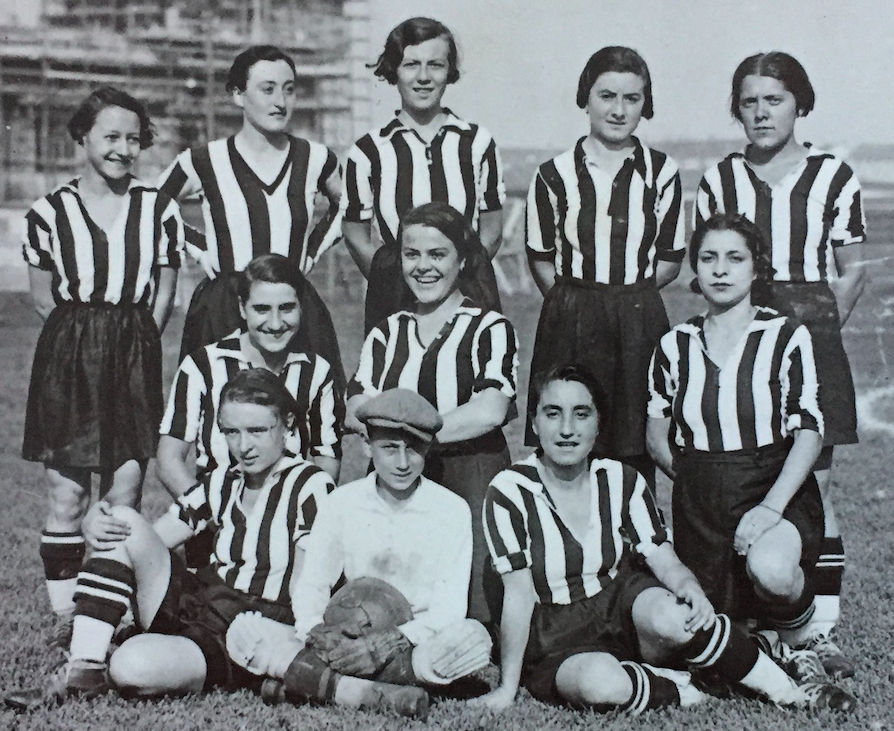
The A team.
The place is Via Alfonso Corti football field, as evident from the analysis of the buildings in the background
(see http://bit.ly/3pAduTw )
Source: Archivio privato Giovanna Boccalini Barcellona
Comparing this photo (which has no caption or writing on the back) with all those of the ‘galleria delle calciatrici’, we can easily identify some players who have very clear visual features: Ester Dal Pan and Ninì Zanetti are the 4th and the 5th in the 1st or back row; Marta Boccalini and Maria Lucchese are the 1st and the 3rd in the middle row; Augusta Salina (on the left) and Luisa Boccalini (on the right) are seated.
Comparing then these first “visual” results with the verbal sources, we can note a lot of coincidences. The sports journalists wrote that Luisa Boccalini played as a right full-back, Maria Lucchese as a midfielder, Ester Dal Pan as inside-forward … and they’re all there on the photograph – where they are supposed to be. The same sources say also that Ninì Zanetti played as inside-forward, and she is in the forward row; although in her autobiography Marta Boccalini wrote that she played as a winger, in this photo she’s in the midfielders’ row, but not in the centre, so we can argue that she played as a left halfback.
Now we can move to the third and more interesting step: moving from the roles as depicted from journalistic sources. All the newspapers says that the centre halfback of the B team was Nidia Glingani: from this information then we can identify the 2nd player in the middle row as her.
A comparison between the two images of Nidia Glingani’s and that of the new player. Please pay attention to the area between eyebrows and upper nose …
Sources: (1) Il Calcio Illustrato, 15/03/1933; (2) Il Calcio Illustrato, 29/03/1933, p. 11; (3) Archivio private Giovanna Barcellona Boccalini.
Moving to the photo of Team B, we notice that there are some new players:
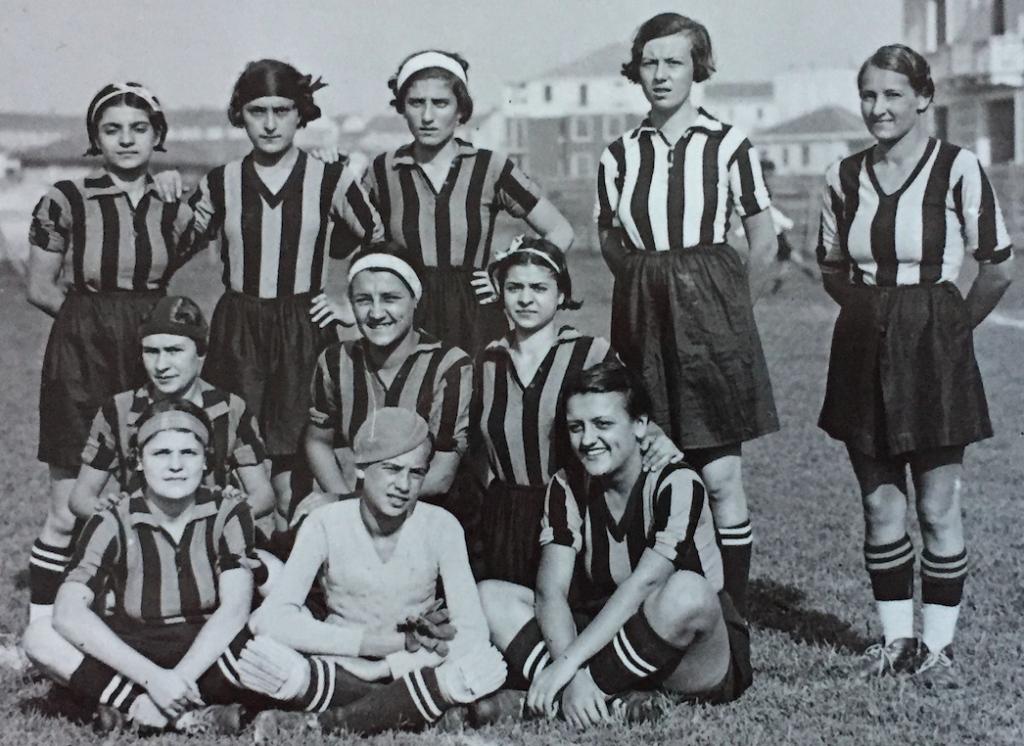
The B team
Note that only half of the players are wearing a standard black-and-blue striped shirt
Also one A Team player in a black-and-white shirt (3rd standing in back row) and 3 of them are wearing V-neck shirts
Source: Archivio privato Giovanna Boccalini Barcellona
Using the previous ‘3-step method’, firstly we can easily identify Rosetta Boccalini (3rd in the 1st/back row), Brunilde Amodeo and Graziella Lucchese (2nd and 3rd in the middle row). When we move to step 2, everything works: Rosetta played as a centre-forward, Brunilde Amodeo as a centre halfback, Graziella Lucchese as a midfielder. Indeed the most interesting element of this photograph is the presence of two girls that are so similar to two of these players that we can suggest that they may well be related to each other.
Let’s start from the 3rd player seated. Playing Pasts readers should remember her face, since in Part 6 (see https://bit.ly/2yKHIOL ) some images of her were published, suggesting she was Brunilde Amodeo. That fact is, Brunilde had a very similar sister, Wanda …
- Wanda wearing a black-and-blue shirt, with V-neck Since the football field is the same, we can argue that this photo was taken on the same day as that of the B team photograph Source: Archivio privato Brunella Bracardi
-
Wanda wearing a GS Cinzano shirt
Source: Archivio privato Rosa Mottino
- Wanda and Brunilde together, at the Romano swimming pool, Milano (see http://bit.ly/3pAduTw ) Source: Archivio privato Brunella Bracardi
In October 2020 myself and Federica Seneghini offically launched ‘Giovinette’ with Giuseppe Sala, Mayor of Milan, as a special guest (see http://bit.ly/2L986ra ). Since on that occasion there were a lot calciatrici‘s heirs, I had the chance to talk again with Francesco Bacigalupo, Brunilde Amodeo’s grandson, whose knowledge was essentail for Part 6 of this series. He introduced me to his cousin Stefano, Wanda’s grandson, and I talked to them about the photo where their grandmothers were both present … Then the talk moved on to the phone call I had some days before.
During the writing of her historical novel, Federica had the idea that ‘C. B.’, the only journalist that wrote, in 1933, in Il Calcio Illustrato without any bias about the calciatrici, was in fact Carlo Brighenti, a very important sports journalist of that time – in fact, he is one of only a few positive male characters in the book. In order to discover something about Brighenti’s life, Federica did some specific research, getting in touch with relatives, discovering that the journalist contacted GFC because of a specific player he knew. It was only after the publication of the book that I decided to phone the Brighenti’s relatives. Roberto, the son of Carlo, told me that his father knew about the calciatrici thanks to one of them. Roberto couldn’t recall her name, yet he gave me two clues: after the war, the mysterious calciatrice lived in the Melchiorre Gioia’s quarter (he gave me the address), and her son, with whom Roberto played as a boy, was called Gualtiero. When I mentioned this male name (quite unpopular, in Italy), Stefano stopped me: Gualtiero, he said, was the name of his father, and her grandmother Wanda Amodeo really lived in that quarter! The circle was closed …
The second very similar looking calciatrice is of course the player standing 1st in the 1st/back row: she is almost a twin of Graziella Lucchese (3rd in the middle row), even wearing a similar white headband! Firstly, we must exclude Graziella’s elder sister Maria, who is seen in the A team photograph. As Playing Pasts readers will remember, Maria and Graziella had a younger sister, Jolanda, who would later join them in Gruppo Sportivo Giovinezza, and became an important figure in Italian women’s cross country (see https://bit.ly/2VFvcs4 ). The older source, regrading Jolanda as a member of GS Giovinezza dates to January 1934, yet comparing the older photo of the GS Giovinezza basketball players from the Summer of 1934 to the B team one above we can see some visual similarities …

Although the quality of this photograph is not very good, note the similarity between the 2nd player standing and that of the 2nd in the front row: Graziella and Jolanda Lucchese?
Note the black-and-blue shirts …
Source: La Domenica Sportiva, 08/06/1934, p. 15
There is however, a third interesting face in this team photo. Look at the player between Jolanda Lucchese and Rosetta Boccalini, wearing a black headband … It’s another face that Playing Pasts readers have already met, in the article about GS Giovinezza, the athletics and basketball sports club that many former football players joined in 1934 (see https://bit.ly/2VFvcs4 ). She is Franca Agorni, a very important athlete of mid-1930s’ Italy, who later joined the Italian National Team in 1936 Berlin Olympics, being a reserve for the 100m relay team
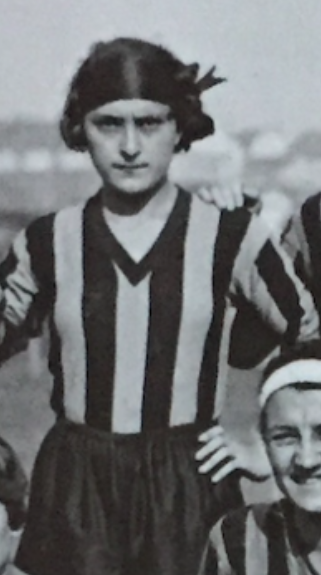
Franca Agorni as GFC football players
(September-October 1933)
Source: Archivio privato Giovanna Boccalini Barcellona
-
Franca Agorni and Brunilde Amodeo
they were both members of GS Filotecnica for a while, in the summer of 1935 (see https://bit.ly/2yKHIOL )
Source: Archivio privato Brunella Bracardi
-
Franca Agorni, the GS Giovinezza athlete
(November 1934)
Source: Source: La Domenica Sportiva, 11/11/1934, p. 12

Franca Agorni at the 1936 Olympics
wearing the Italy National Team tracksuit
Source: https://twitter.com/calciatrici1933/status/1051408530404765696
We already know that on 1 October 1933, when the FIDAL athletics trainers joined a GFC meeting, taking the time for a 50m sprint for all football players, in order to find some up-and-coming runners, Franca Agorni was among the fastest ones, with Ninì Zanetti, Ester Dal Pan and Maria Lucchese: but she could have been an outside athlete, brought by the FIDAL trainers. This new photo enables us to identify Franca in other images, all taken at the Alfonso Corti football field: she is always wearing the GS Cinzano shirt, which from September 1933 became the shirt of the 3rd team (that of Marta Boccalini, Jolanda Lucchese and Wanda Amodeo).
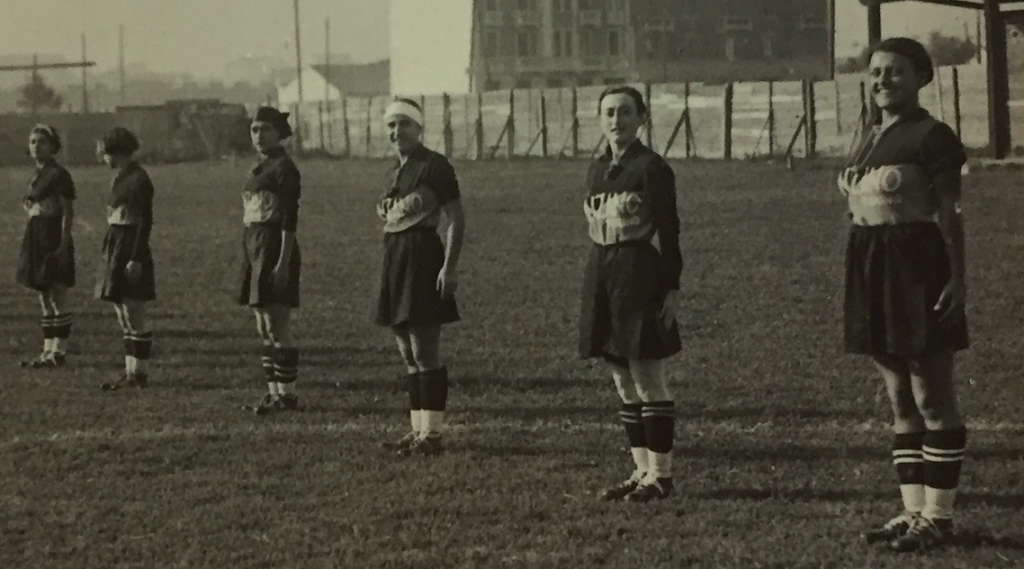
Six GS Cinzano players (October 1933)
from left, Jolanda Lucchese, ?, Franca Agorni, Marta Boccalini, ?, Wanda Amodeo
Source: Archivio privato Rosa Mottino
Research using journalistic sources can also be very useful for historical reconstruction especially when we move away from the 1930s’. As we know, men tend to write history, so it’s quite impossible to find some clues regarding the calciatrici in the following decades, by which time many of them were married (changing their family names, a nightmare for the historical researcher …) and resumed their professional careers as clerks and teachers. The sad case of Jole Mantoan illustrates how adult life was hard, for some of the former calciatrici …
We know a little about Jole’s sporting activity during the GFC adventure: being 19-years old, she played as a midfielder in the A black-and-white team, and then in GS Cinzano in both the June and July matches.
-
Jole
Image 1
Sources: (1) Il Calcio Illustrato, 15/03/1933; (2) Il Calcio Illustrato, 26/07/ 1933, p. 7.
-
Jole, in football kit, 1933,
Image 2
In 1936, Jole married a man from the Piacenza mountains, named Gino Prandi. 30 years later, in 1966, Italian newspapers started to talk about her. Jole Mantoan, a 52 years-old Milanese prostitute, who worked in the Corvetto quarter, was attacked by Giovanni Cassoni, attempting to take all her money. Jole passed out and assuming she was dead, the man threw her in a local canal; then Jole was saved by a guard. Giovanni was denounced and then arrested by the Italian police, but the truth would be revealed by the first investigation: the man who attacked was not – as she said – a hobo friend of her, but her pimp. Recounting Jole’s life, the journalists had no pity, describing her as an old drunkard, addicted to vice and to the bottle; from these sources, we know that she had been previously been incarcerated in a number of psychiatric hospitals.
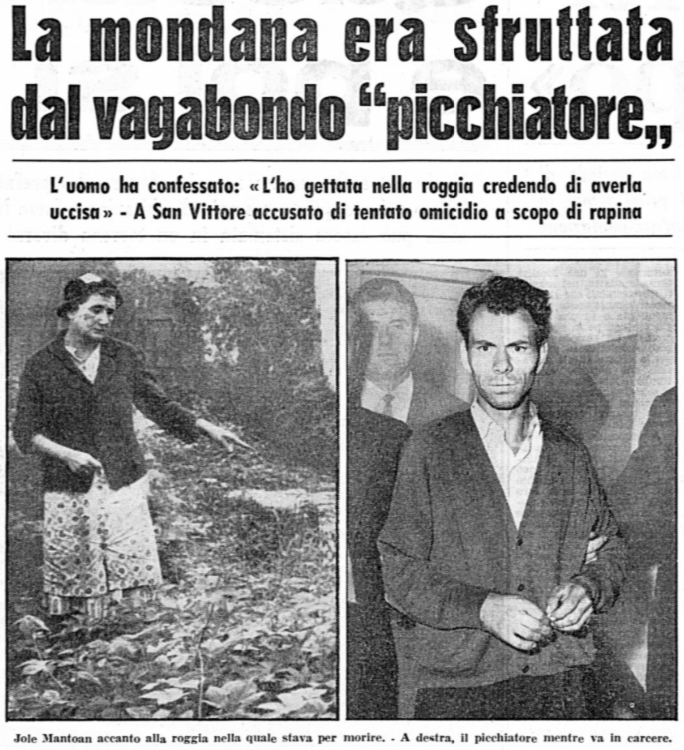
On the left, Jole pointing to the canal where she was thrown; on the right, her attacker Giovanni Cassoni
Source: Corriere d’Informazione, 18-19/08/1966, p. 4.
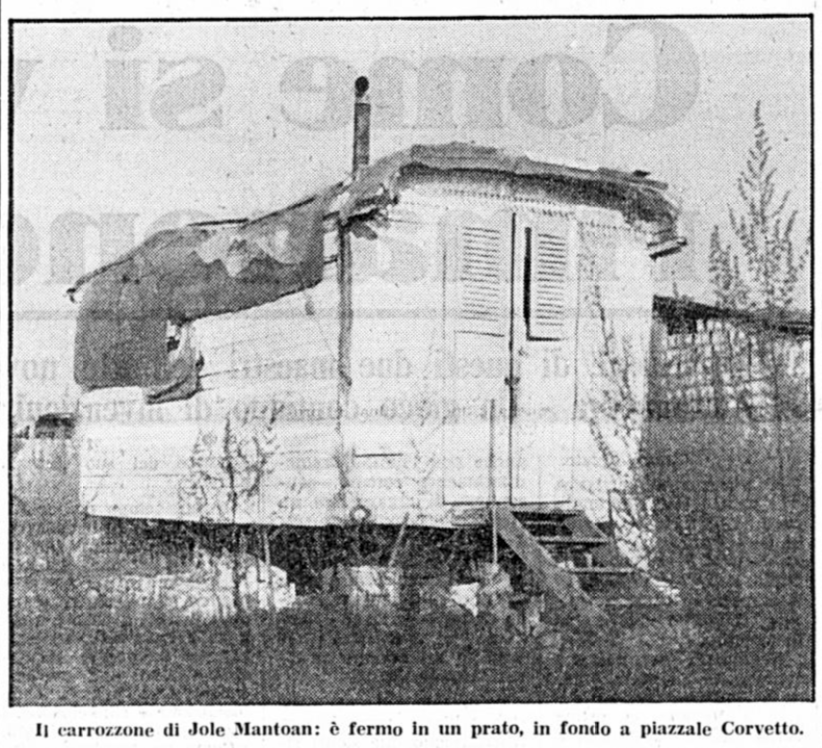
This dilapidated wagon, located in the outskirts of Milan, was the miserable house where Jole lived with a drunkard (not her legal husband, neither her attacker)
Source: Corriere d’Informazione, 17-18/08/1966, p. 4.
A year later the investigation reeached the sentencing stage, but to add insult to injury: Giovanni was absolved because due to mental illness, while Jole was condemned for public lewdness!
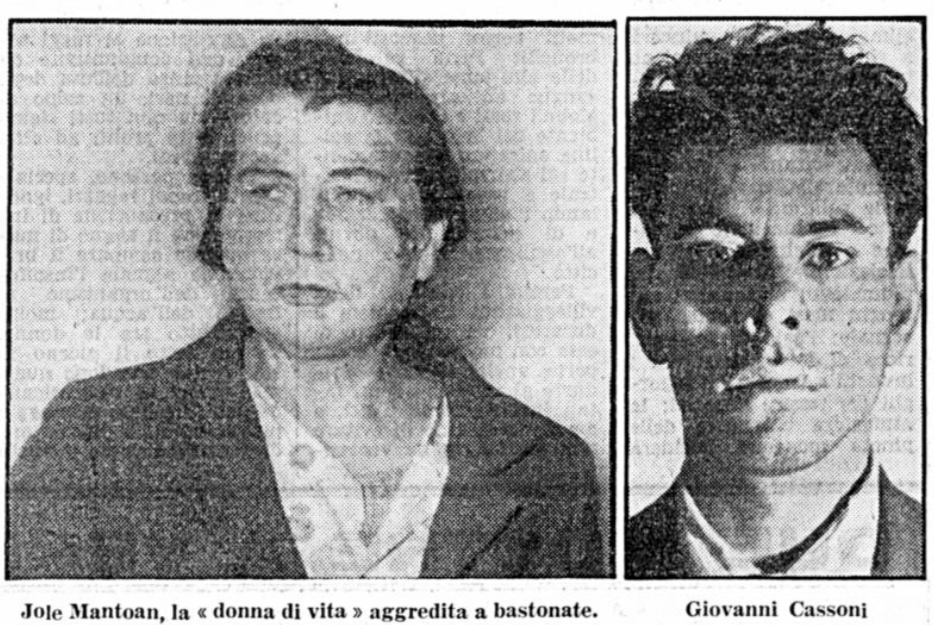
Jole and Giovanni
Note the sign of the attack on Jole’s right cheek
The newspaper call her “donna di vita”, “mondana” in a previous clipping: these were hypocritical terms used during those years in order not to use the term “prostituta”
Source: Corriere d’Informazione, 17-18/08/1966, p. 4.
One may wonder whether Jole’s former teammates read these articles, and tried to help her: unfortunately, we don’t know if that was the case. No file about Jole’s sad story could be found, for example, in Giovanna Boccalini Barcellona’s private archive: but there we did find some elements that proved useful in reconstructing the biography of further GFC players …
As already referred to in Part 8, after her husband’s imprisonment and condemnation in Summer of 1933, Giovanna started to write a lot of letters to the small Tremiti islands, where Giuseppe was confined (see https://bit.ly/3a8bNrH ). She was not the only one, among Boccalini sisters: Luisa also wrote, in particular to announce her wedding with Giovanni Mottino, Marta and Rosetta also wrote to their brother-in-law.
Giuseppe answered, too. Writing to Marta Boccalini on 8 November 1933 from the Tremiti islands, asking his sister-in-law: ‘Please, say hello to Dal Pan, remind her of the Wednesday 3 – 0’. He is referring here to the Milan derby, played on Wednesday 1 November 1933: Ambrosiana-Inter were victorious over AC Milan, 3-0.
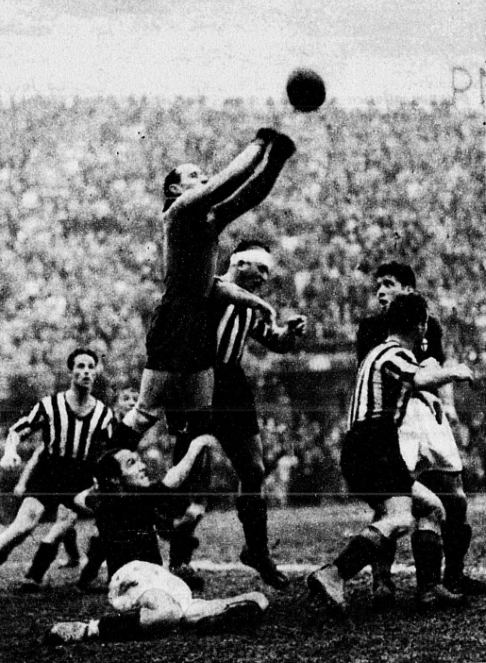
The return match
Ambrosiana-Inter again beat AC Milan, 2 – 1
In this photo, AC Milan goalkeeper Perversi is warding off the ball, jumping over Ambrosiana-Inter player Levratto, recognizable by his bandage
Source: La Domenica Sportiva, 18/03/1934, p. 7.
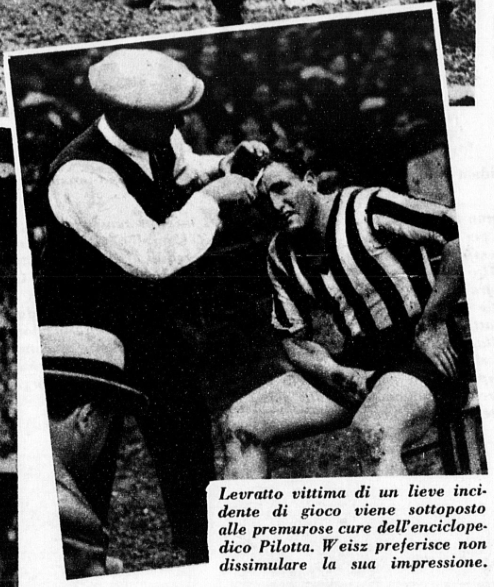
How Levratto had got his bandage, during the same match
Sports medicine was quite crude …
Source: La Domenica Sportiva, 18/03/1934, p. 7.
This subtle teasing by Giuseppe was directed, by Ambrosiana-Inter fan Giuseppe, to the first GFC calciatrice , recognisable as an AC Milan supporter. The 19 years-old Ester was the daughter of Attilio Dal Pan, one of Giuseppe’s colleagues at the Tax Office, where Ester was working too (did the father put a good word for his daughter with his boss, getting her a job as a clerk?). In Giovanna’s archive we can see some photos of Giuseppe with his colleagues: Ester Dal Pan is there, too … in a very different outfit!
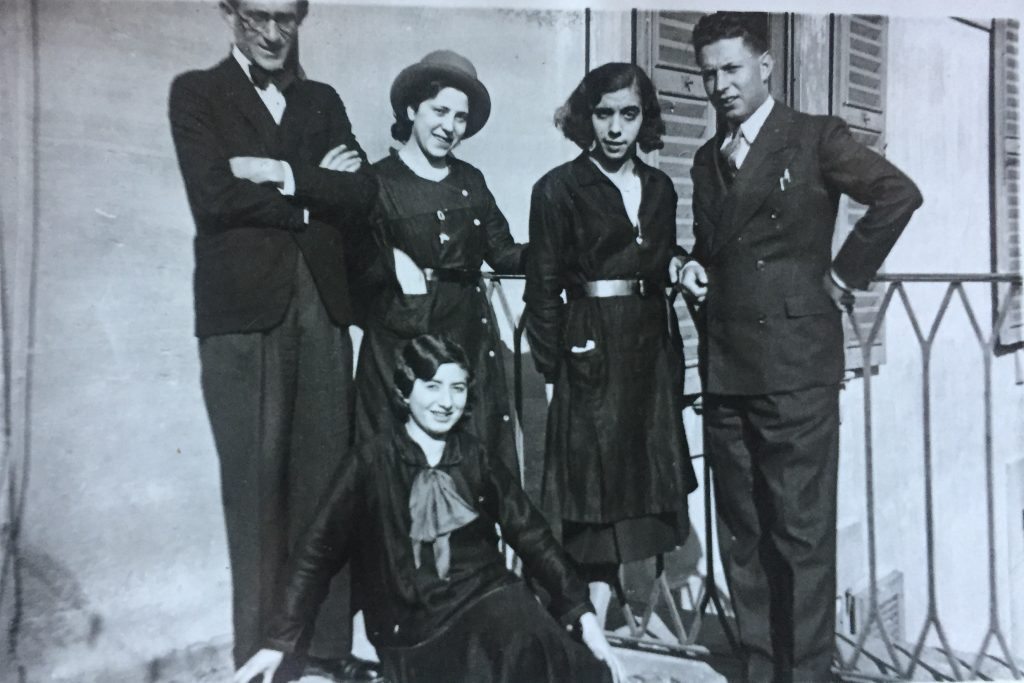
Giuseppe Barcellona (3rd standing) with colleagues
1st seated is Ester Dal Pan
Note all the women are wearing black suits, standard dress for female clerks in 1930s’ Italy
Source: Archivio privato Giovanna Boccalini Barcellona
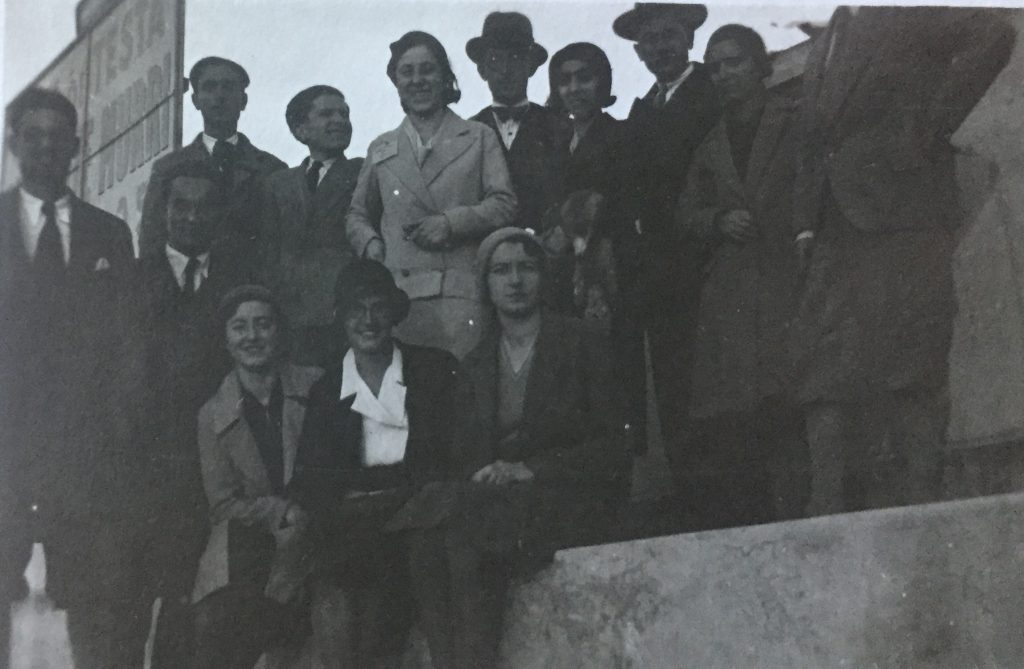
Football or basketball fans attending a match
Ester Dal Pan is next to Giovanna Boccalini Barcellona (wearing glasses)
Source: Archivio privato Giovanna Boccalini Barcellona
Relying on these elements we can perhaps understand why Ester Dal Pan was the only GFC player to which the 3 Boccalini sisters honoured with a photograph depicting them alongside their 2 nephews. Were they willing to send a copy of this picture to the Tremiti islands?
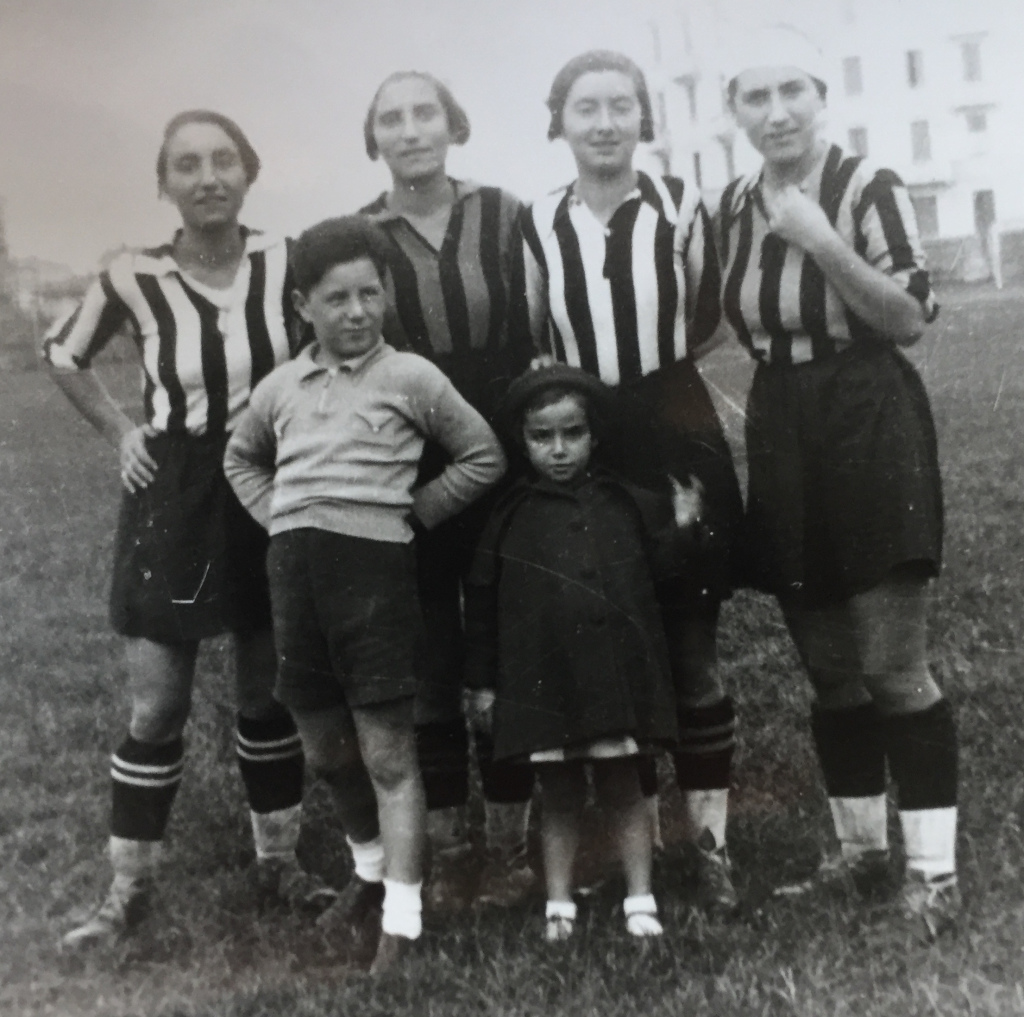
1st row: Luisa Boccalini, Rosetta Boccalini, Ester Dal Pan, Marta Boccalini
2nd row: Giacomo and Grazia Barcellona
Source: Archivio privato Rosa Mottino
Yet the letters preserved in Giovanna’s archive showed us that before being arrested Giuseppe became a friend of other football players, more famous than Ester Dal Pan … On 26 August 1933 Giovanna writes to Giuseppe:
Sorry, I had to stop writing to you, because I got a visit. Guess who? Armando Castellazzi. He stayed more than two hours, because he wanted to know every element of our pitiful odyssey. He asked me to express to you his lovely friendship, and to give regards also for his brother and for his family. He is going to come back around the 22th of September, to have further infos. He will by person to you, too.
Armando Castellazzi (1904-1968) was an Ambrosiana-Inter midfielder: Giuseppe Barcellona was friend of this future 1934 Champion of the World!
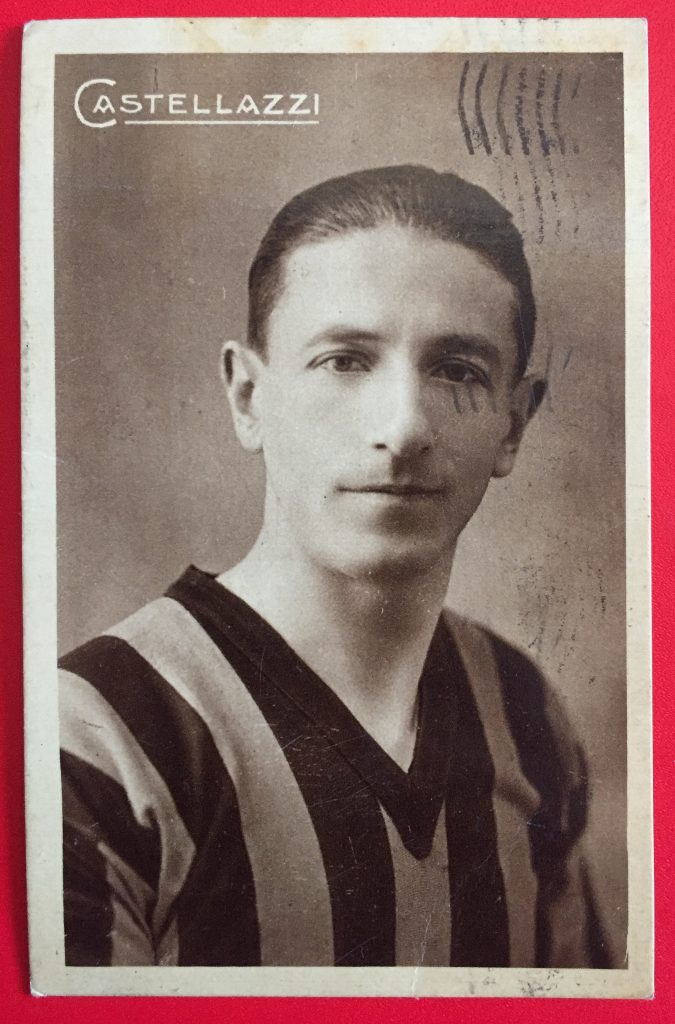
A 1934 postcard depicting Castellazzi: for this series, see https://bit.ly/3a8bNrH
Source: Archivio privato Giovanna Boccalini Barcellona.
In fact, Castellazzi won the title in a quite casual way, since he was among the reserves called up by coach Vittorio Pozzo. He played only in the quarter-final against Spain: before this (his first, and last international match with the Azzurri team) he had only played twice, in friendly matches against Portugal (1929) and Switzerland (1930) …
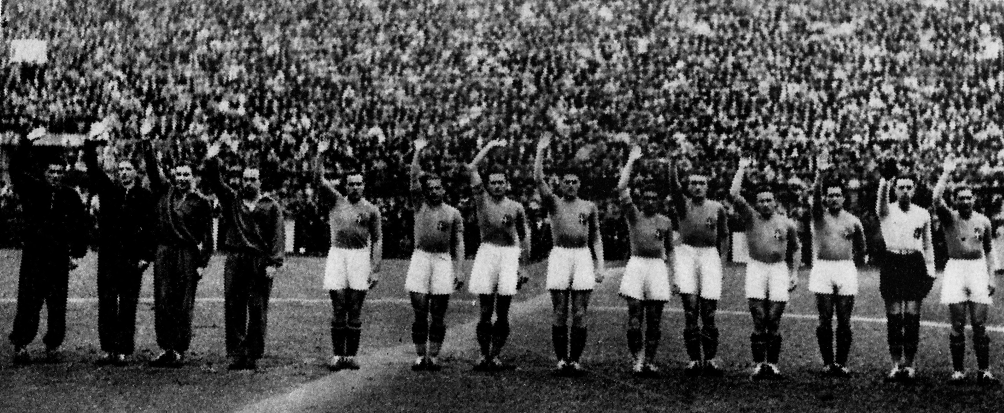
In this photo taken in Milan, 25 March 1934
Castellazzi is on the left, among the reserves of Italy (Arcari, Castellazzi, Borel II & Ferrari), during the qualification match against Greece
see https://youtu.be/eCMeFtDYU20
Source: La Domenica Sportiva, 01/04/1934, p. 5.
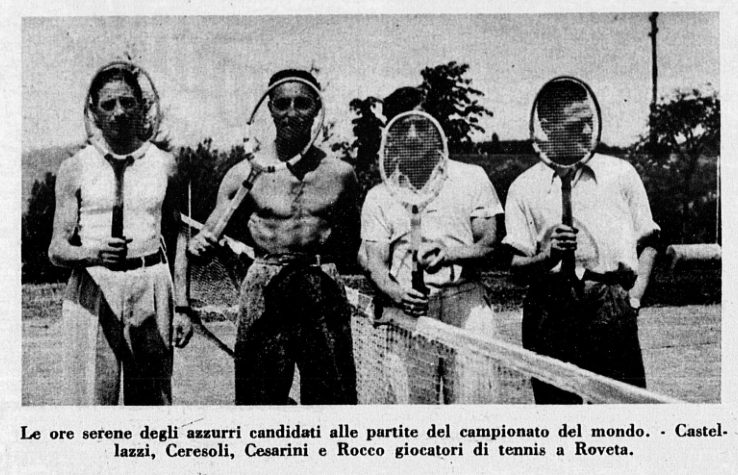
Perhaps not a champion, Castellazzi might have been a good teammate, as this relaxation-time photo shows
taken during the Azzuri stage before the World Cup, in Roveta
Source: La Domenica Sportiva, 20/05/1934, p. 3.
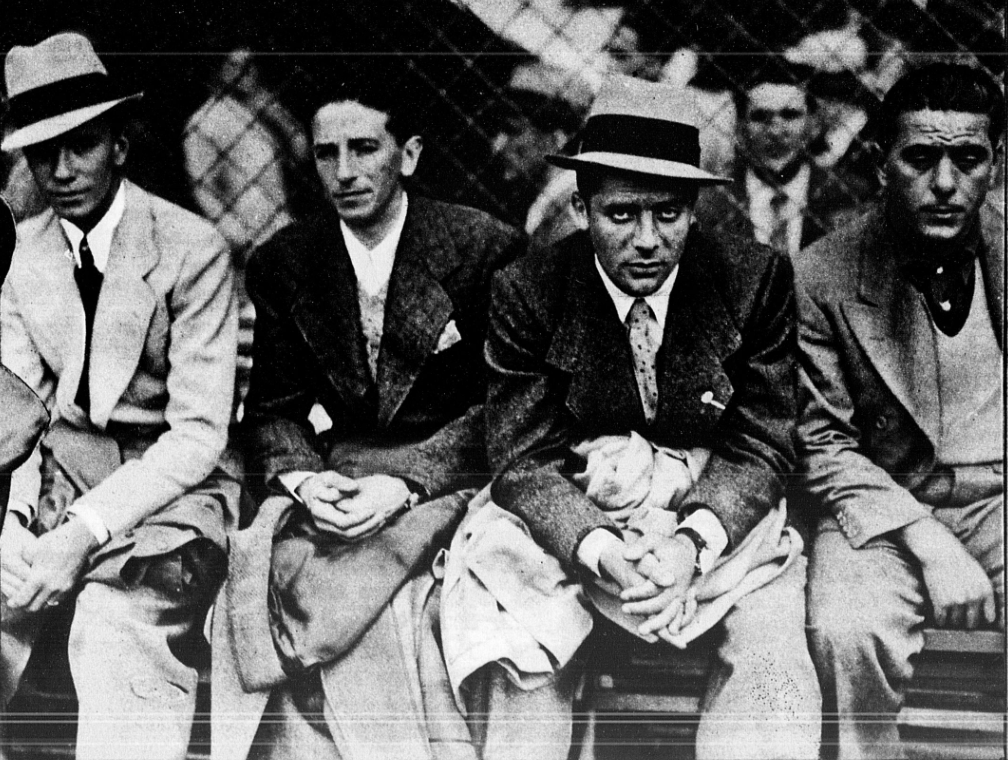
Another photo taken in Roveta
Borel II, Castellazzi, Meazza and Attilio Ferraris watching the Fiorentina – Manchester match, at the Berta Stadium (Florence)
Source: La Domenica Sportiva, 20/05/1934, p. 3.
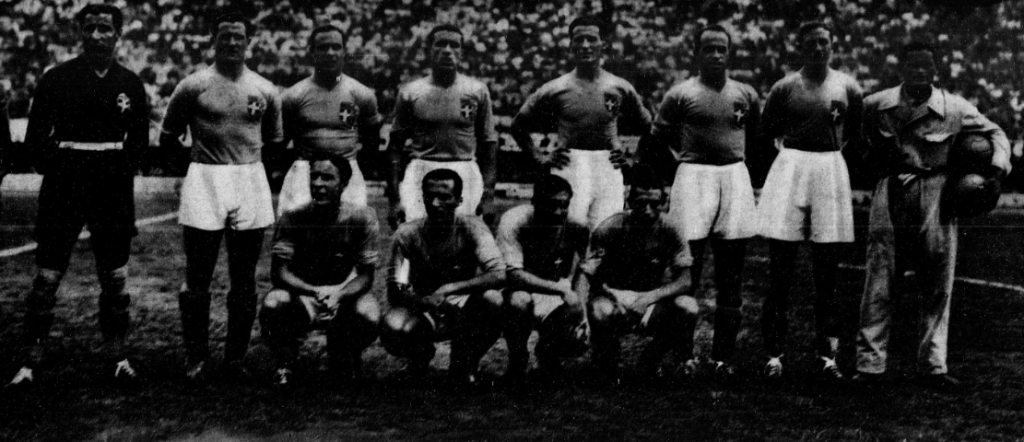
The Italian team that played against Spain during 1934 World Cup
Source: La Domenica Sportiva, 01/06/1934.
Even after the victory in the Summer of 1934, Armando visited Giovanna, in order to get some news about Giuseppe: although he did the standard Roman salute at the beginning of each Serie A match, he could soothe the wife of an enemy of the Fascist regime. An small example of how Italian people tried to survive during those years …
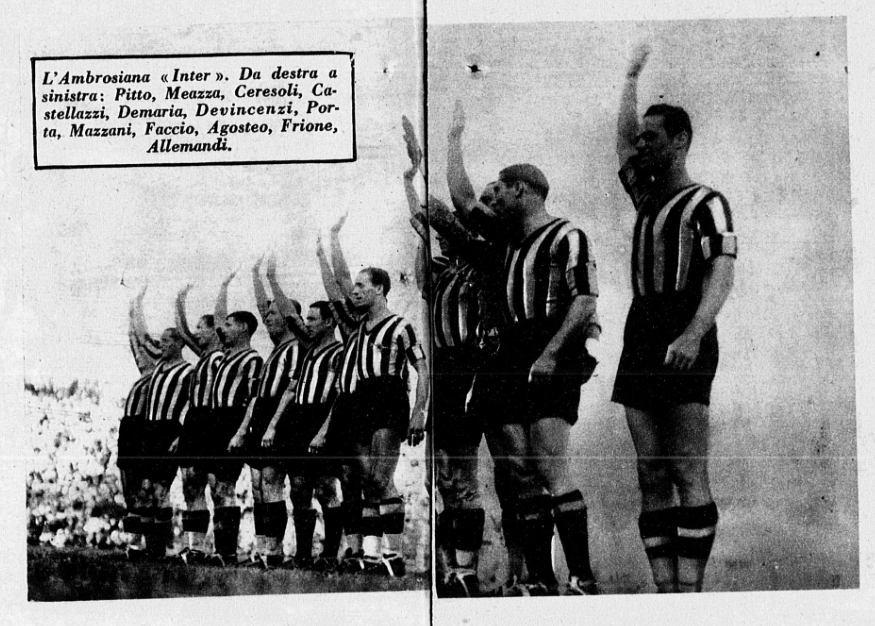
Ambrosiana-Inter players performing the Roman salute during a 1934/1935 match
Source: La Domenica Sportiva, 30/09/1934, pp. 6-7.
The friendship between Armando Castellazzi and Giuseppe Barcellona introduced us to a time long ago, when Serie A players were famous, but not so unreachable for the Milanese people … In a letter written on 8 October 1933, Giovanna writes to Giuseppe:
This morning, while I was watching a GFC match, I met Levratto and Allemandi, who had been introduced by Castellazzi.
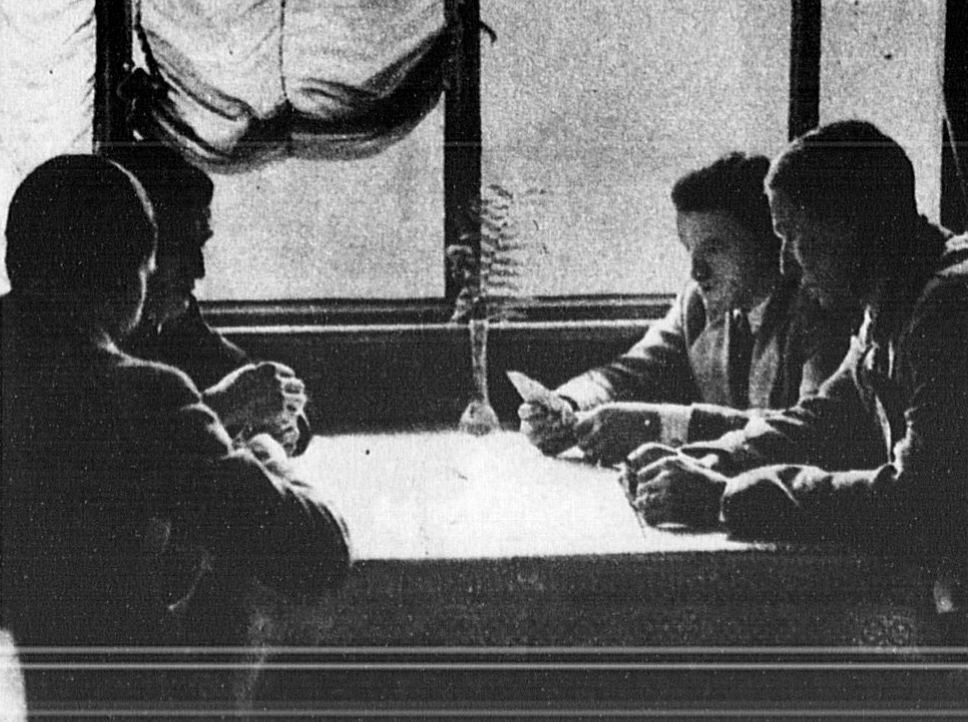
Faccio, Levratto, Viani and Castellazzi playing cards before the derby against AC Milan
Source: La Domenica Sportiva, 18/03/1934, p. 6.
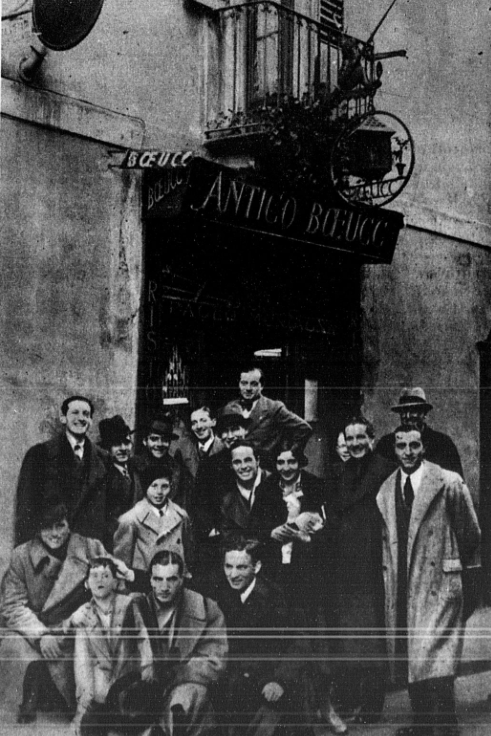
The Ambrosiana-Inter team lunch before the match against Padova Standing, from the left: Allemandi, Meazza, Castellazzi, Faccio, Pitto, Agosteo, Ceresoli 2nd row: Levratto, Frione, Serantoni Source: La Domenica Sportiva, 11/02/1934, p. 3.
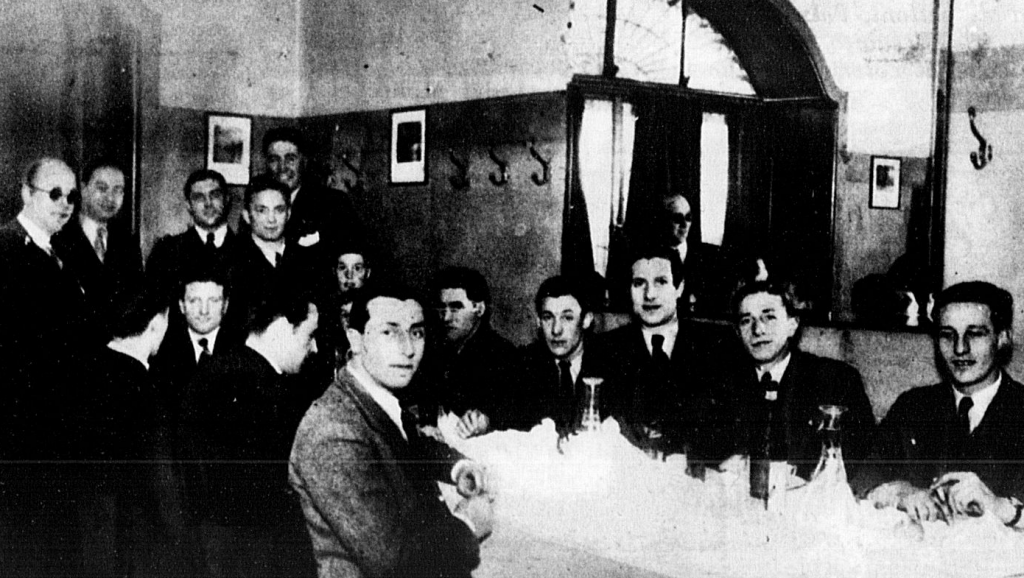
During lunch
Seated, from right: Allemandi, Castellazzi, Agosteo, Demaria, Faccio; at the head of the table: Levratto
followed by: Frione, Pitto, Ceresoli
Standing: Bossi (manager), coach Weisz, Meazza e Serantoni
Note that this photo isn’t very different from those of Ambrosiana women’s basketball players
a reminder that Giuseppe Meazza and Rosetta Boccalini were players at the same sports club! (see http://bit.ly/3bm6MKY )
Source: La Domenica Sportiva, 11/02/1934, p. 4.
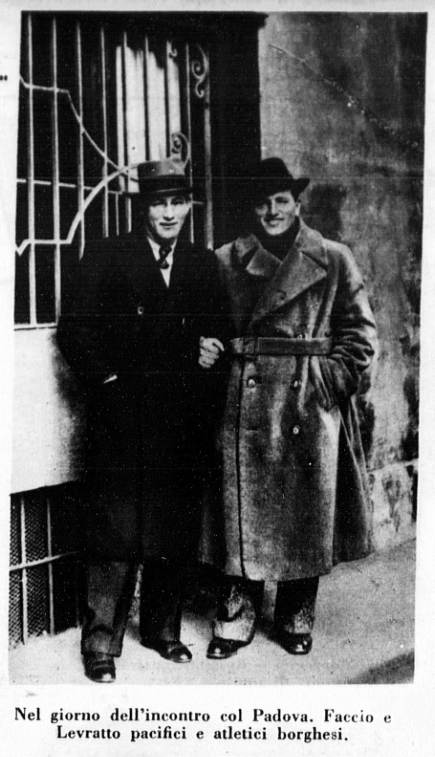
Ambrosiana-Inter players Faccio and Levratto outside the restaurant, in civilian clothes
Source: La Domenica Sportiva, 11/02/1934, p. 4.
They were not so untouchable, women had some chance to met them …
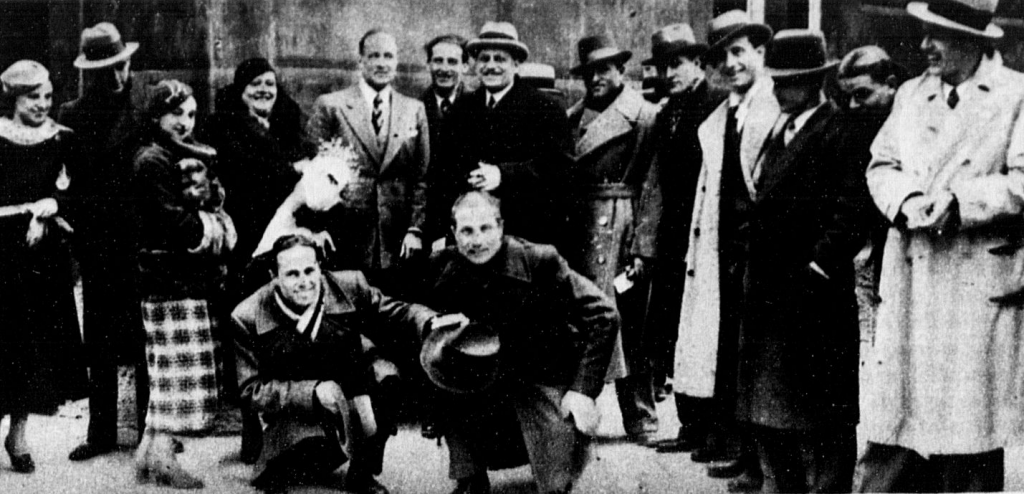
Ambrosiana-Inter players and managers in Alessandria, for an away match
The third woman from left is Mrs. Pozzani, wife of Ambrosiana-Inter President
Next: Emilio Colombo (manager), Gigi Allemandi, Pozzani (President), Levratto, Faccio, Ceresoli, De Manzano, Degani
In the centre: Pitto and Agosteo
Source: La Domenica Sportiva, 25/02/1934, p. 6.
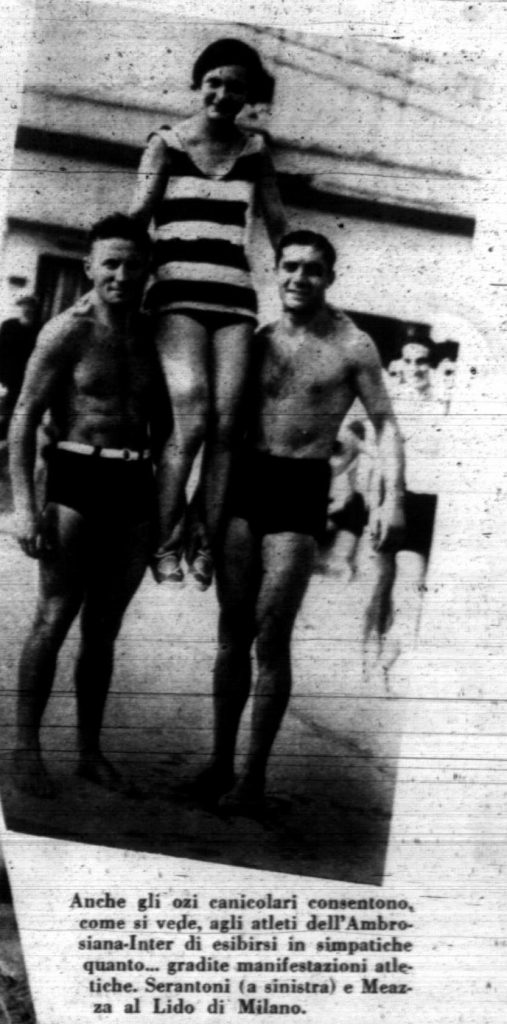
Ambrosiana-Inter players Serantoni and Meazza carrying a girl, in a Milanese public lido
The photo is taken from the very same page where a letter by Ninì Zanetti was published, asking why Italian women couldn’t playing football as their Serie A idols …
Source: La Domenica Sportiva, 28/08/1932, p. 11.
Writing to Giuseppe on 9 April 1934, Giovanna tells him about the match she attended the day before, Ambrosiana-Inter – Bologna, at the Arena Civica stadium:
Such an exciting match: a tight game, until the very last minute. In my opinion, the best player of the match was Castellazzi. If you only could watch him playing! He’s marvellous, and he plays always with style
Giuseppe answered:
Please give my regards to Castellazzi. Thanks to the newspapers, I’m following his style of game: kind, stylish and gainful
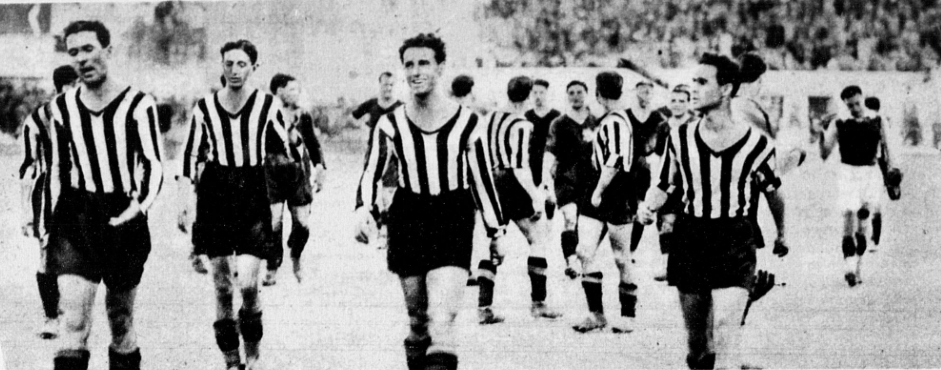
Agosteo, Castellazzi, Allemandi and Pitto leaving the field after the match against Genoa (0-0)
Source: La Domenica Sportiva, 08/04/1934, p. 6.
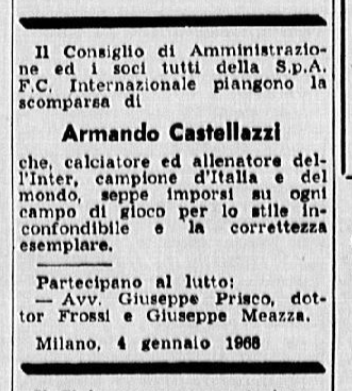
On the occasion of the death of Armando Castellazzi in 1968
former mates Giuseppe Meazza and Annibale Frossi (and legendary Vice-President Peppino Prisco, too) praised his style and fair play
Source: La Gazzetta Dello Sport, 05/01/1968, p. 5.
The letters written by Giovanna to Giuseppe are important mostly because, via their correspondence we can better understand what really happened to the GFC, especially after the regime’s ban in Autumn 1933. On 14 May 1933 she writes to her husband, still in a Milanese jail
This morning I resumed my activity as GFC team manager, after having stopped it for my illness: President [Ugo Cardosi] was willing to ask you to take care of the team because he’s going to be admitted for surgery. I answered that you were outside Milan for business reasons. When I saw your colleague Dal Pan I guess that I was going to surrender to the wave of sorrow that was coming from my heart, yet I was able to bravely stand up, and after some minutes I was back again your Nina [Giovanna’s nickname], brave and strong: so no players could notice my feelings.
At the end of May Giovanna describes to Giuseppe a GFC match played at Rogoredo football field, stressing the performances of her sisters:
Last Sunday the calciatrici gathered at the Rogoredo football field. The two teams, in the formations I’ve already told you, played two half times: the black-and-blue won 3 – 1, thanks to their good forwards. The defense of the black-and-white team worked well (Gina was a giant!), so the black-and-blue forwards worked hard to win. Rosetta scored 2 goals, and made the assist for the 3rd, by [Elena] Cappella.
During the summer, Giovanna had the permission to spent some time with Giuseppe: she left Milan with Giacomo and Grazia, in order to reach the Tremiti islands. When she returned, everything had changed, and the GFC was coming along … Giovanna writes, on 30 September:
Finally yesterday I could have a meeting with Mr. Cardosi, GFC President: although I had sent him a postcards from San Severo [a small city in front of the Tremiti Islands], she couldn’t believe that I was back. We talked for more than two hours about the future of GFC, which has been invited to play with its teams in several cities, adding to the proposal from the Alessandria GFC, whose team had already defeated a local male kids team, 5 -3. We had to play this match in Alessandria tomorrow (1st of October), but the match was delayed, because the authorities hadn’t yet given us the permission. This evening I’m going to went, together with another lady of GFC Direttorio, to the Sports Office of the Fascist Federation, in order to ask the permission to reach the city of Fidenza: we had been invited to play on the local patronal feast (8th of October). Who knows whether we will be able to gain it!
Some hours later, Giovanna writes again, with the latest news:
Our mission with higher authorities has failed. We have no permission for Alessandria, Fidenza, Tradate or any place to where we’ve been invited. Never mind, we will go on as we did up to now, waiting for better days.
One week later, on Sunday 8 October, Giovanna writes:
This morning, on the field of the Signorine [young ladies: Giovanna was a married woman] I had the opportunity to know better Levratto and Allemandi, whom I was introduced to by Castellazzi. They both marvelled watching Rosetta play – she recovered from an annoying muscle strain -, and Gina too, who is an unbeatable fullback.
After describing to Giuseppe the good qualities of the GFC male coach (probably De Ruschi, the team manager of AC Milan juniors team) and that all the players were going to gather at Giovanna’s house on Thursday evening for a lesson in football theory, she admits that, in order to gain permission, the GFC was forced to create an athletics department, and were waiting for an athletics trainerto be sent by the FIDAL …
On 26 October 1933 Marta writes to Giuseppe:
I had to send you these photographs: they are the proof of the diligence we use to practice good gymnastics, guided by coach De Ruschi. You will find a double copy of the photo in which Elia is depicted, you have to give it to Calogero [Barcellona, Giuseppe’s brother]: please keep the other ones for you return, that I hope will be not so late. Did you recognize Dal Pan? And what about me? Did Nina describe my football qualities? I was learning [how to play], and I was training more regularly … Never mind, who knows whether I had a further chance to wear the football shirt? In fact, Mr. Cardosi resigned as GFC President. Will we find another one in spit of him?
On 6 November Giovanna explained to her husband what had happened with Ugo Cardosi:
On Sunday morning [our son Giacomo] always come with me to the pitch where the Signorine play: yet two times the bad weather has ruined our fun. Don’t worry about my position inside of GFC, everything goes so right that you don’t have to worry. Neither I nor the GFC could put more pression on President [Cardosi]: in fact, he resigned because of some things I told him during a GFC meeting. (This is the official reason). But the real reason is that … I guess Mr. Cardosi founded the group because he was hoping for some award: since now the authorities are done with us, he got tired and step down. Anyway, all these things have a relative value: the main point is that GFC will go on working and … it does it, always with passion!
The optimistic spirit of Giovanna would counterbalance her delusion in Cardosi’s behaviour: in fact, she accused him of political opportunism. Since there was no more male president, all the managerial work fell on Giovanna, whose main goal became … finding a new male president!
After some talks, in February 1934 (please remember that the very last journalist source we have is dated December 1933!) Giovanna was able to send an official letter to GFC members on a new headed norepaper, the address on which was … her own!
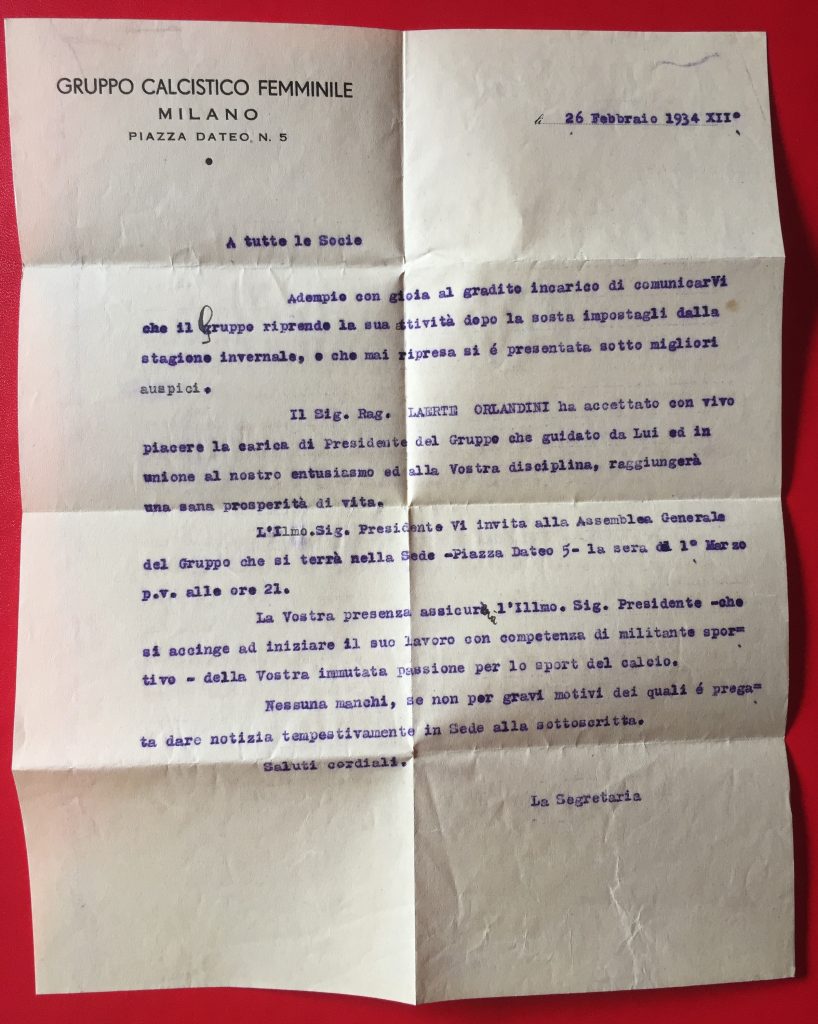
Giovanna’s official letter to all GFC members (26 February 1934)
Source: Archivio privato Giovanna Boccalini Barcellona

The headed notepaper
the address of GFC has changed from Via Stoppani 12 to Piazzale Dateo 5, that is, from Ugo Cardosi wine shop to Giovanna’s house
Source: Archivio privato Giovanna Boccalini Barcellona
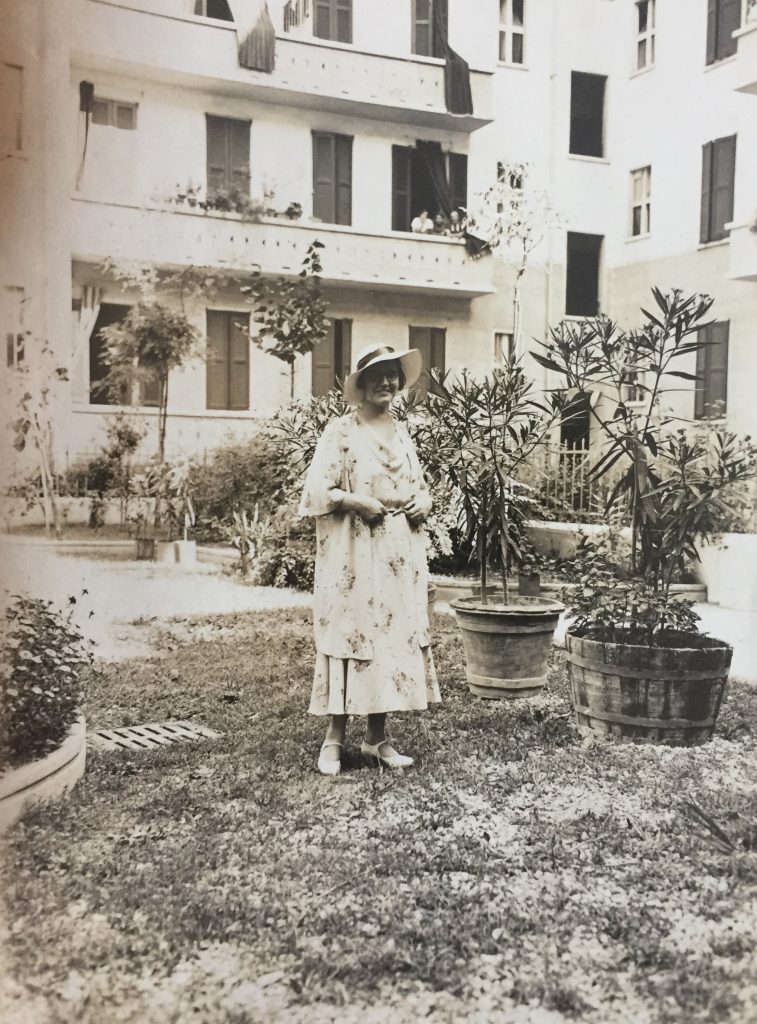
Giovanna in the courtyard of Piazzale Dateo, 5 (1933)
Source: Archivio privato Giovanna Boccalini Barcellona.
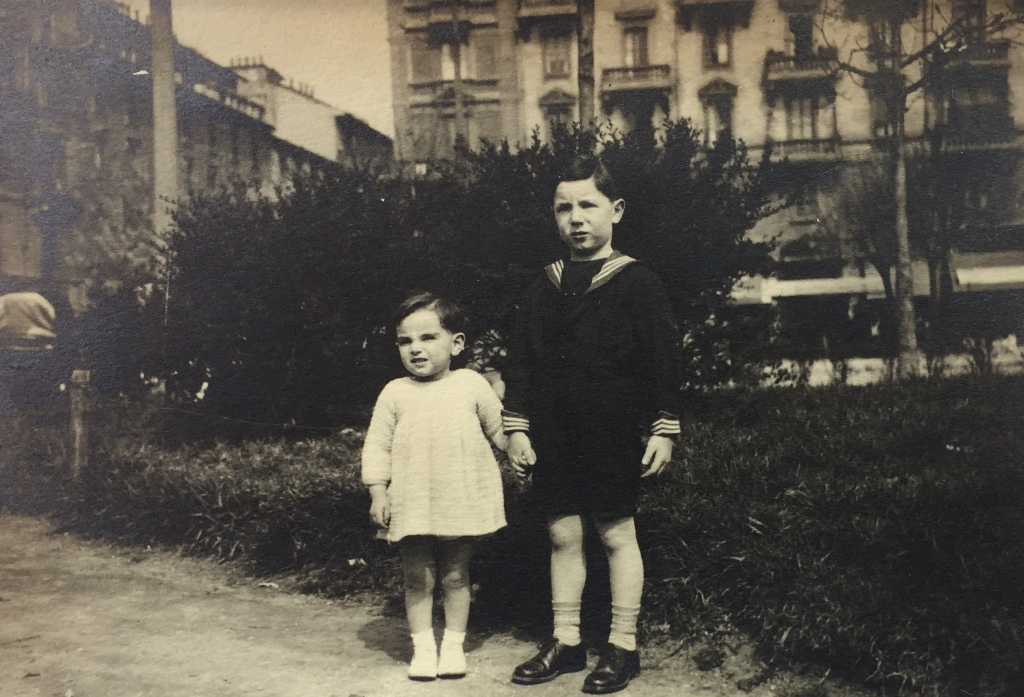
Grazia and Popi in front of their house, in Piazzale Dateo, 5 (1931?)
Source: Archivio privato Marta Boccalini.
The main news announced by Giovanna (who signed as the Segretaria, ‘secretary’ and ‘spokeswoman’ of GFC, a role that had previously belonged to Losanna Strigaro, during the Ugo Cardosi’s age) was that GFC had a new President: Laerte Orlandini, not only a member of Ambrosiana-Inter, but also one of the founders, in 1908!
On 6 March 1934 Giovanna writes to Giuseppe, underlining the new spirit of Orlandini’s Presidency:
The GFC was born again, leaded by a serious-minded and sporting man. Not a wide program, yet a minimum program: no horn-honkers, no grandstanding, no pretenses. Just sports for sports, for the sake of all GFC members. We’re having a lot of problems in renting a football pitch, because athletics society are hogging the City Council ones. On the other part, we’ve already found a gym where we’re going to have our athletics training, on Tuesday. As you can see, we’re working with commitment and relying on better basis
The new President, Laerte Orlandini, was able to find a new football pitch, in Via Cambini. The GFC also changed kit: the calciatrici abandoned their skirt for more practical shorts, and the shirts changed to light-blue (1st) and white (2nd). Unfortunately, there are no photographs of these shirts …
On 19 April 1934 Luisa Boccalini married: which meant, of course, the end of her sporting carrier: but also the adventure of calciatrici were brought to an end.
The very last letter regading GFC was written not by Giovanna, but by Rosetta. Her last words sound quite ironic, recalling that football blows on chest and on pelvis were one of the reasons why the male child goalkeeper was introduced under the special women’s ‘medical’ rules. She writes to Giuseppe, on 27 April 1934:
On the other part, I’m sure that I’m doing my duty. I study a lot, I cannot do more than this! The weather is starting to became hotter. I go on playing football, on Sunday morning; except for those days when I have a lot to study, such as last Sunday. After having done a lot of gymnastics, we’ve started using the ball – the first kicks! I guess I’m still quite fit. I’m very good in trapping the ball by chest.
Then, the team disappeared, and so the memory of it did too. Watching all her sisters and former team-mates dying through the decades, Marta Boccalini remained as one of the last witnesses of GFC. Although Gina and Rosetta were better at playing football, she had another role: she was the keeper of the team’s memory, and of something even older. When she was interviewed by Ercole Ongaro in 1978, she remembered of the courtyard of the Boccalini family, in Lodi (where the family lived, before moving to Milan, in 1927). Marta says that when she was a girl that small and poor courtyard was full of kids:
We used to play at 23, we played football, using hands. I wonder how could we play in such a small place? That courtyard … it was big as this living room: how could we do that?
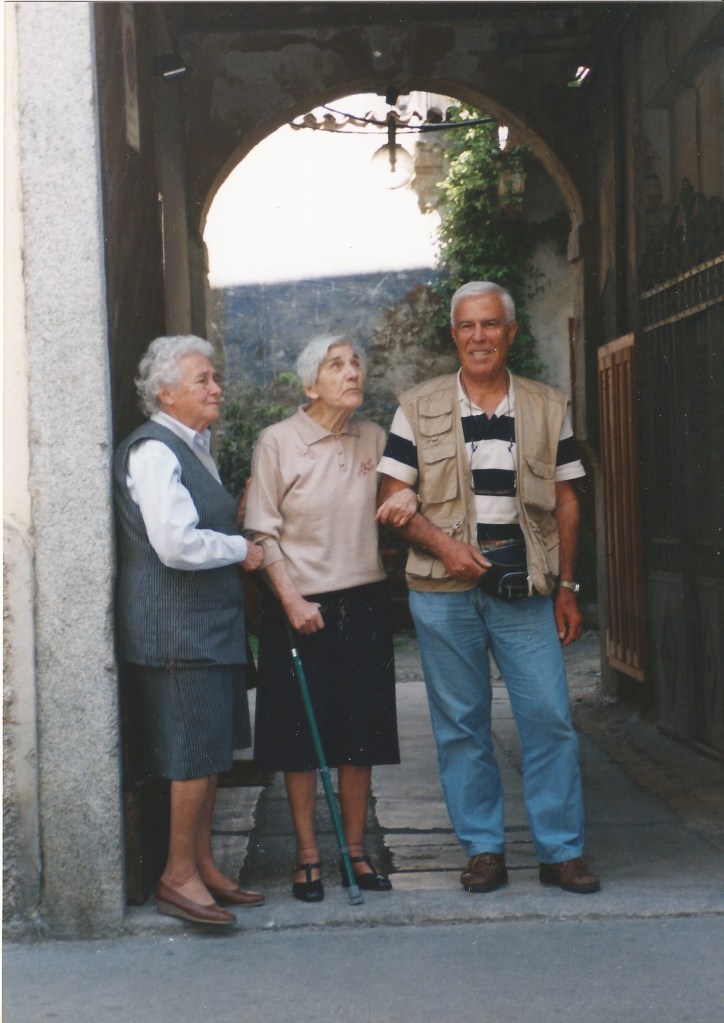
Some years before her death, Marta Boccalini had the chance to visit for the last time her hometown, Lodi
In this picture she is looking at the entrance to the old Boccalini house, where she was born, and where she learnt to play ball games together with her sisters and brothers …
Source: Archivio private Rosa Mottino.
Article © of Marco Giani
Read Part 11 – HERE
For the “galleria delle calciatrici”, see:
https://sorelleboccalini.wordpress.com/extra_gfc_la-galleria-delle-calciatrici/
For Alberto Schiavi and Marco Giani’s study about the Milanese football fields used by the calciatrici in 1933, see:
Extra_GFC_I campi delle calciatrici

![“And then we were Boycotted”<br>New Discoveries about the Birth of Women’s Football in Italy [1933] <br> Part 10](https://www.playingpasts.co.uk/wp-content/uploads/2021/01/Boycotted-Part-10-Marco-Giani.jpg)
